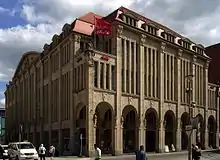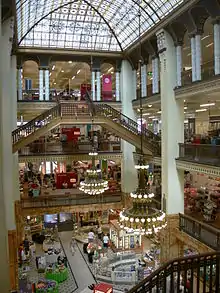Görlitz Department Store
The Görlitz department store in Görlitz is one of the best preserved department stores from the beginning of the twentieth century. It is built in the Art Nouveau style[1] and was operated as a department store until August 15, 2009. The city and a citizens' action group tried to revitalize the department store which in 2012 housed only a beauty shop. In 2013, a private investor was found, who would like to obtain the facility as a universal department store, as the Department Store of Upper Lusatia (Kaufhaus der Oberlausitz, KaDeO) and thus a counterpart to the Berlin department store Kaufhaus des Westens (KaDeWe).[2][3]

History
Construction
Located on the present site in 1717 was the "Goldener Strauß" (Golden Ostrich) inn, which later was expanded into a hotel. The Görlitz city council wanted a department store on this site and in fact followed the model of the Berlin Wertheim department store on Leipziger Platz. The Potsdam architect Carl Schmanns provided the construction plans for the "department store at the ostrich." In 1912, after the demolition of the hotel, the new construction began as a steel skeleton which received a facade entirely based on the desired model in Art Nouveau. After nine months of construction time, the department store was opened on September 30, 1913. The management of the store lay in the hands of a small middle class firm.
1929 to 2010

In 1929 Rudolph Karstadt AG acquired the department store. The Karstadt owners were ousted after the Second World War and in 1950 the store was acquired by the German Democratic Republic, which let it be run by the state Handelsorganisation (HO). In 1958, it became a Centrum department store and consequently was part of an entire chain of such department stores in several cities of the GDR. In 1984, HO began the restoration of the historic facade and the interior rooms. After reunification the department store was given back to the Karstadt group. In subsequent restructuring of the company, it was put into the Karstadt Kompakt division, which was sold on October 1, 2005, to a British investment group, the Dawnay Day group. On March 1, 2007, these stores received the historical name "Hertie", as did the Görlitz department store. On 20 May 2009 Hertie owner Dawnay Day announced that this and all other Hertie branches would close by the end of July. The city searched for a new investor for the building. On 3 June 2009 federal chancellor Angela Merkel announced that the department store was detached from Hertie's insolvency and was to be individually sold. An investor from Great Britain took it over; however, in 2010 it was again abandoned. Thus the historically-listed building closed its doors. At the request of the city, from 8 February 2010 the building was in receivership to solve the problem of its further use more quickly. Apart from a reopening as a department store, use as a museum was also discussed. The vacant building was repeatedly a victim of vandalism. A citizen's initiative has even formed to rescue the department store; however, it has not found a solution.
Range
The department store last sold clothing, candy, furniture, and other types of products except for groceries. Because of the closeness of the border with Poland, all the signs were written in two languages. Some of the salespeople were fluent in both languages. Euro and złoty were equally accepted for payment.
Fresh start
In June 2013 Winfried Stöcker acquired the department store. It should again be operated as a department store. The reopening was planned for 2016, then for the fall of 2017, until it became clear that a sizeable restoration and renovation would be necessary first. It is unclear when this will begin and when a new warehouse might open in the building.[4]
Film set
The US film director Wes Anderson searched for a realistic location for the film The Grand Budapest Hotel and found the Görlitz department store.[5] The open galleries of the atrium floors were filled in to resemble corridors, with hotel rooms opening off the atrium. The entire film team, among others the actress Tilda Swinton and the actors Willem Dafoe and Ralph Fiennes, stayed in neighboring Hotel Börse during the several months of shooting.[6]
References
- "Welcome to Görlitz, the perfect German town that’s a movie star in its own right" by Ryan Gilbey, The Guardian, 20 January 2015
- "Professor Stöcker und sein Traum vom Luxus-Kaufhaus", by Steffen Gerth, Der Handel, 29 July 2013 (in German)
- "KaDeO – das Kaufhaus in Görlitz" Archived 2015-07-12 at the Wayback Machine by Liane Watzel, Mitteldeutscher Rundfunk, 6 February 2014 (in German)
- Miriam Schönbach, "Görlitzer Jugendstil-Kaufhaus vor Sanierung", Lausitzer Rundschau, 27 August 2017. Accessed 1 October 2017 (in German)
- "Step Into the Spectacular World of Wes Anderson's The Grand Budapest Hotel", Architectural Digest, March 2014
- "Oscars: See How an Old Department Store Became a Grand Budapest Hotel" by Sharon Swart, The Hollywood Reporter, 15 December 2014
External links
 Media related to Jugendstilkaufhaus Görlitz at Wikimedia Commons
Media related to Jugendstilkaufhaus Görlitz at Wikimedia Commons- Official website
- Jugendstilkaufhaus (Art Nouveau department store), goerlitz.de (in German)